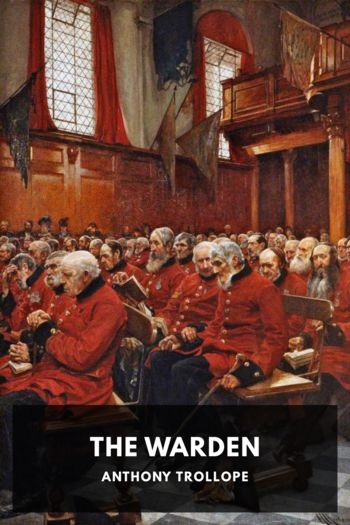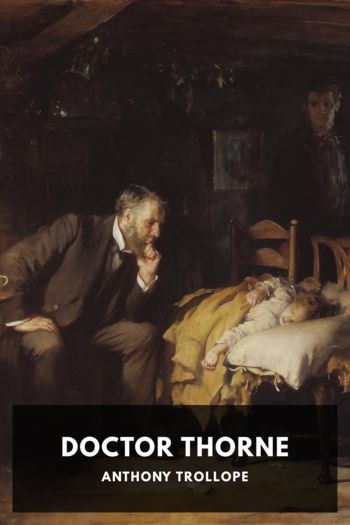Barchester Towers by Anthony Trollope (e reading malayalam books TXT) 📕

Description
Barchester Towers, published in 1857, is the sequel to Trollope’s The Warden and continues the story of the clerical doings in the fictional cathedral town of Barchester.
As this novel opens, the old Bishop of Barchester lies dying, and there is considerable doubt as to who will replace him. The Bishop’s son Dr. Grantly, the Archdeacon, has high hopes of succeeding him, but these hopes are dashed and a new Bishop, Dr. Proudie, is appointed. Along with Dr. Proudie comes his domineering wife and their ambitious chaplain the Reverend Mr. Slope.
The old clerical party headed by Dr. Grantly and the new, championed by Mrs. Proudie and Mr. Slope, are soon in contention over Church matters. These two parties represent a then-significant struggle between different evangelical approaches in the Church of England. One local issue in particular is fought over—the appointment of a new Warden for Hiram’s Hospital, the focus of the preceding book.
Mrs. Eleanor Bold is the daughter of Mr. Harding, the prior Warden. She has recently been widowed. The wealth she inherited from her late husband makes her an attractive match, and her affections are in contention from several prospective suitors, including the oily Mr. Slope. All of this lends itself to considerable humor and interest.
Though not well received by critics on its initial publication, Barchester Towers is now regarded as one of Trollope’s most popular novels. Together with The Warden, it was made into a very successful television series by the BBC in 1982.
Read free book «Barchester Towers by Anthony Trollope (e reading malayalam books TXT) 📕» - read online or download for free at americanlibrarybooks.com
- Author: Anthony Trollope
Read book online «Barchester Towers by Anthony Trollope (e reading malayalam books TXT) 📕». Author - Anthony Trollope
In her person and her dress she was perfect, and well she knew her own perfection. She was a small, elegantly made old woman, with a face from which the glow of her youth had not departed without leaving some streaks of a roseate hue. She was proud of her colour, proud of her grey hair which she wore in short crisp curls peering out all around her face from her dainty white lace cap. To think of all the money that she spent in lace used to break the heart of poor Mrs. Quiverful with her seven daughters. She was proud of her teeth, which were still white and numerous, proud of her bright cheery eye, proud of her short jaunty step; and very proud of the neat, precise, small feet with which those steps were taken. She was proud also, ay, very proud, of the rich brocaded silk in which it was her custom to ruffle through her drawing-room.
We know what was the custom of the lady of Branksome—
Nine-and-twenty knights of fame
Hung their shields in Branksome Hall.
The lady of Ullathorne was not so martial in her habits, but hardly less costly. She might have boasted that nine-and-twenty silken skirts might have been produced in her chamber, each fit to stand alone. The nine-and-twenty shields of the Scottish heroes were less independent and hardly more potent to withstand any attack that might be made on them. Miss Thorne when fully dressed might be said to have been armed cap-a-pie, and she was always fully dressed, as far as was ever known to mortal man.
For all this rich attire Miss Thorne was not indebted to the generosity of her brother. She had a very comfortable independence of her own, which she divided among juvenile relatives, the milliners, and the poor, giving much the largest share to the latter. It may be imagined, therefore, that with all her little follies she was not unpopular. All her follies have, we believe, been told. Her virtues were too numerous to describe, and not sufficiently interesting to deserve description.
While we are on the subject of the Thornes, one word must be said of the house they lived in. It was not a large house, nor a fine house, nor perhaps to modern ideas a very commodious house, but by those who love the peculiar colour and peculiar ornaments of genuine Tudor architecture it was considered a perfect gem. We beg to own ourselves among the number, and therefore take this opportunity to express our surprise that so little is known by English men and women of the beauties of English architecture. The ruins of the Colosseum, the Campanile at Florence, St. Mark’s, Cologne, the Bourse and Notre Dame are with our tourists as familiar as household words; but they know nothing of the glories of Wiltshire, Dorsetshire, and Somersetshire. Nay, we much question whether many noted travellers, men who have pitched their tents perhaps under Mount Sinai, are not still ignorant that there are glories in Wiltshire, Dorsetshire, and Somersetshire. We beg that they will go and see.
Mr. Thorne’s house was called Ullathorne Court—and was properly so called, for the house itself formed two sides of a quadrangle, which was completed on the other two sides by a wall about twenty feet high. This wall was built of cut stone, rudely cut indeed, and now much worn, but of a beautiful, rich, tawny yellow colour, the effect of that stonecrop of minute growth which it had taken three centuries to produce. The top of this wall was ornamented by huge, round stone balls of the same colour as the wall itself. Entrance into the court was had through a pair of iron gates so massive that no one could comfortably open or close them—consequently, they were rarely disturbed. From the gateway two paths led obliquely across the court: that to the left reaching the hall-door, which was in the corner made by the angle of the house, and that to the right leading to the back entrance, which was at the further end of the longer portion of the building.
With those who are now adepts in contriving house accommodation, it will militate much against Ullathorne Court that no carriage could be brought to the hall-door. If you enter Ullathorne at all, you must do so, fair reader, on foot, or at least in a bath-chair. No vehicle drawn by horses ever comes within that iron gate. But this is nothing to the next horror that will encounter you. On entering the front door, which you do by no very grand portal, you find yourself immediately in the dining-room. What, no hall? exclaims my luxurious friend, accustomed to all the comfortable appurtenances of modern life. Yes, kind sir, a noble hall, if you will but observe it; a true old English hall of excellent dimensions for a country gentleman’s family; but, if you please, no dining-parlour.
Both Mr. and Miss Thorne were proud of this peculiarity of their dwelling, though the brother was once all but tempted by his friends to alter it. They delighted in the knowledge that they, like Cedric, positively dined in their true hall, even though they so dined tête-à-tête. But though they had never owned, they had felt and endeavoured to remedy the discomfort of such an arrangement. A huge screen partitioned off the front door and a portion of the hall, and from the angle so screened off a second door led into a passage which ran along the larger side of the house next to the courtyard. Either my reader or I must be a bad hand at topography, if it be not clear that the great hall forms the ground-floor of the smaller portion of the mansion, that which was to your left as you entered the





Comments (0)